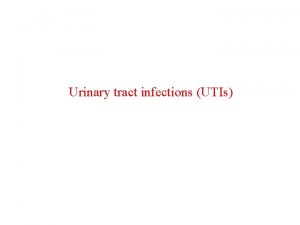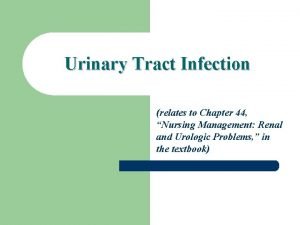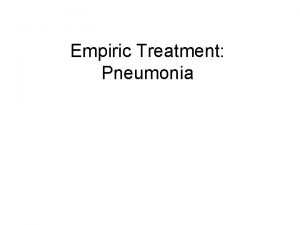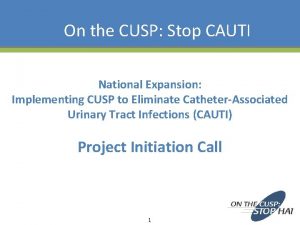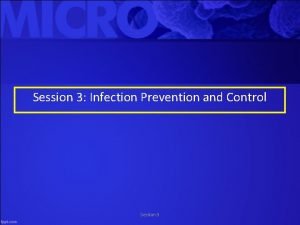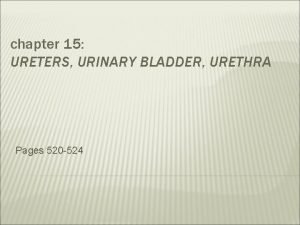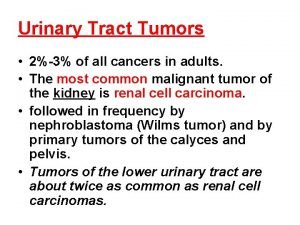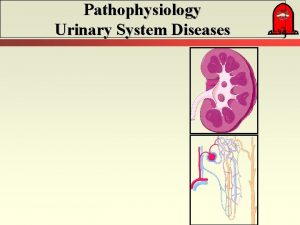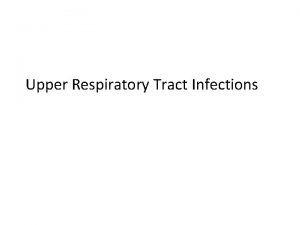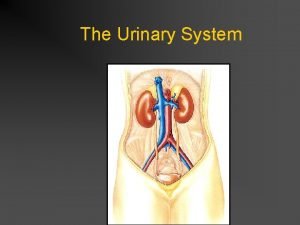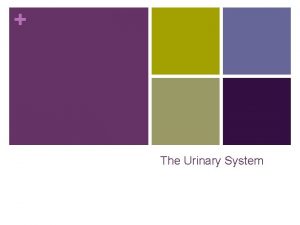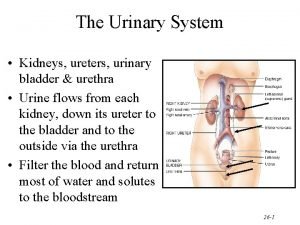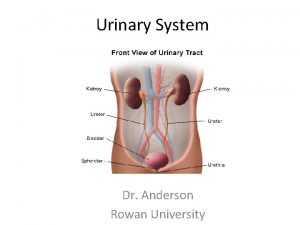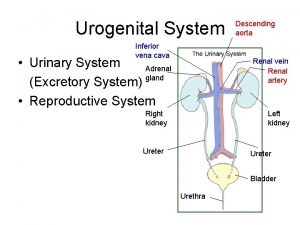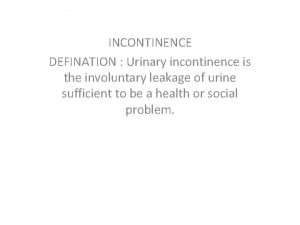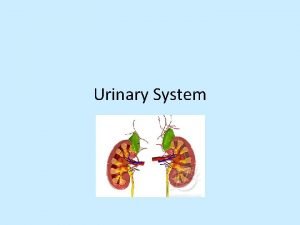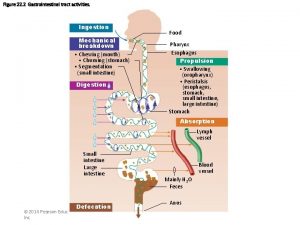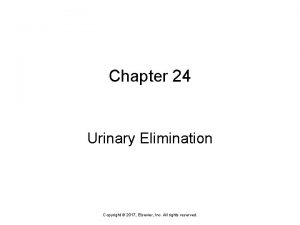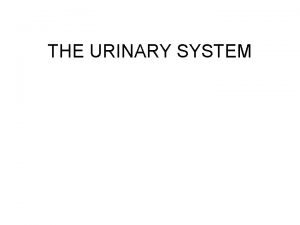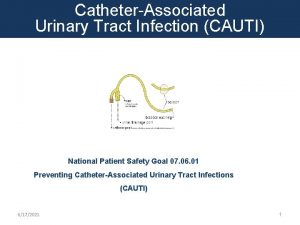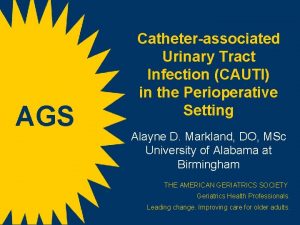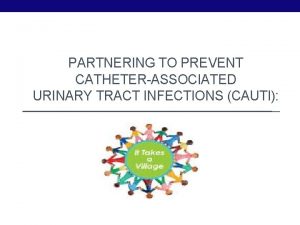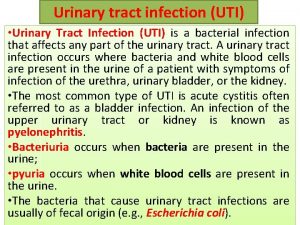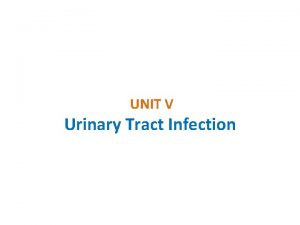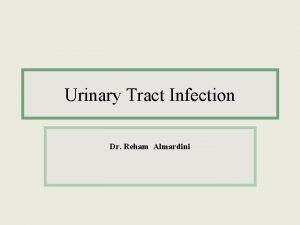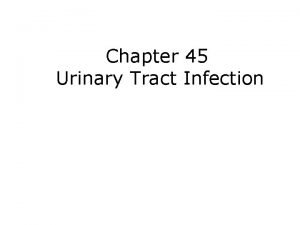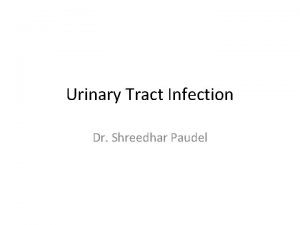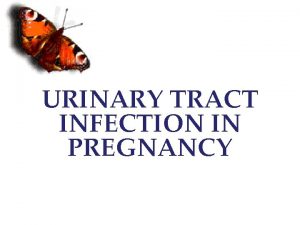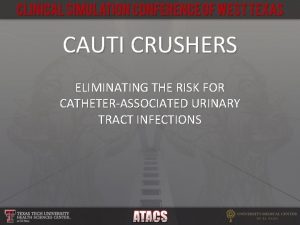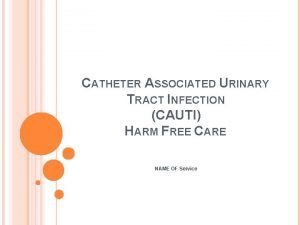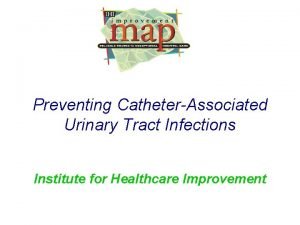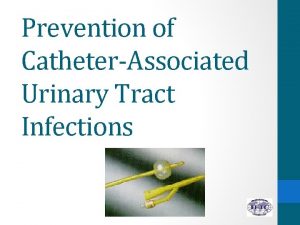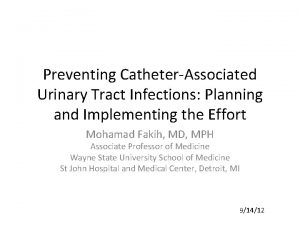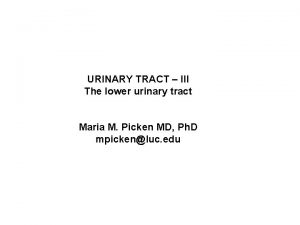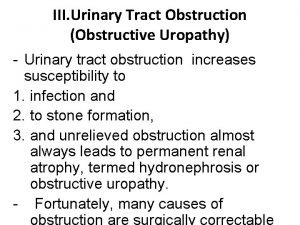Catheterassociated Urinary Tract Infection CAUTI Toolkit Activity C
































- Slides: 32

Catheter-associated Urinary Tract Infection (CAUTI) Toolkit Activity C: ELC Prevention Collaboratives Carolyn Gould, MD MSCR Division of Healthcare Quality Promotion Centers for Disease Control and Prevention Disclaimer: The findings and conclusions in this presentation are those of the authors and do not necessarily represent the views of the Centers for Disease Control and Prevention.

Outline • • Background – Impact – HHS Prevention Targets – Pathogenesis – Epidemiology Prevention Strategies – Core – Supplemental Measurement – Process – Outcome Tools for Implementation/Resources/References

Background: Impact of CAUTI • Most common type of healthcare-associated infection – > 30% of HAIs reported to NHSN – Estimated > 560, 000 nosocomial UTIs annually • Increased morbidity & mortality – Estimated 13, 000 attributable deaths annually – Leading cause of secondary BSI with ~10% mortality Excess length of stay – 2 -4 days • • Increased cost – $0. 4 -0. 5 billion per year nationally • Unnecessary antimicrobial use Hidron AI et al. ICHE 2008; 29: 996 -1011 Givens CD, Wenzel RP. J Urol 1980; 124: 646 -8 Klevens RM et al. Pub Health Rep 2007; 122: 160 -6 Green MS et al. J Infect Dis 1982; 145: 667 -72 Weinstein MP et al. Clin Infect Dis 1997; 24: 584 -602 Foxman B. Am J Med 2002; 113: 5 S-13 S Cope M et al. Clin Infect Dis 2009; 48: 1182 -8 Saint S. Am J Infect Control 2000; 28: 68 -75

Background: Urinary Catheter Use • • • 15 -25% of hospitalized patients 5 -10% (75, 000 -150, 000) NH residents Often placed for inappropriate indications Physicians frequently unaware In a recent survey of U. S. hospitals: – > 50% did not monitor which patients catheterized – 75% did not monitor duration and/or discontinuation Weinstein JW et al. ICHE 1999; 20: 543 -8 Munasinghe RL et al. ICHE 2001; 22: 647 -9 Warren JW et al. Arch Intern Med 1989; 149: 1535 -7 Saint S et al. Am J Med 2000; 109: 476 -80 Benoit SR et al. J Am Geriatr Soc 2008; 56: 2039 -44 Jain P et al. Arch Intern Med 1995; 155: 1425 -9 Rogers MA et al J Am Geriatr Soc 2008; 56: 854 -61 Saint S. et al. Clin Infect Dis 2008; 46: 243 -50

Background: HHS Metrics and Prevention Targets • # of symptomatic UTI / 1, 000 urinary catheter days as measured in NHSN – National 5 -Year Prevention Target: 25% decrease from baseline • Appendix G in HHS plan discusses a new type of metric, the standardized infection ratio (SIR) http: //www. hhs. gov/ophs/initiatives/hai/prevtargets. html http: //www. hhs. gov/ophs/initiatives/hai/appendices. html

Background: Pathogenesis of CAUTI * Source of microorganisms may be endogenous (meatal, rectal, or vaginal colonization) or exogenous, usually via contaminated hands of healthcare personnel during catheter insertion or manipulation of the collecting system Figure from: Maki DG, Tambyah PA. Emerg Infect Dis 2001; 7: 1 -6

Background: Pathogenesis of CAUTI • Formation of biofilms by urinary pathogens common on the surfaces of catheters and collecting systems • Bacteria within biofilms resistant to antimicrobials and host defenses • Some novel strategies in CAUTI prevention have targeted biofilms Scanning electron micrograph of S. aureus bacteria on the luminal surface of an indwelling catheter with interwoven complex matrix of extracellular polymeric substances known as a biofilm Photograph from CDC Public Health Image Library: http: //phil. cdc. gov/phil/details. asp

CAUTI Definitions • Surveillance definitions for UTI recently modified in NHSN (as of Jan 2009) – Please refer to NHSN Patient Safety Manual http: //www. cdc. gov/nhsn/library. html • Count symptomatic UTI (SUTI) only, not asymptomatic bacteriuria (ASB) – Exception is “ABUTI” (asymptomatic bacteremic UTI) – see NHSN manual above • Clinical significance of ASB unclear – Should not screen for or treat ASB routinely, except in certain clinical situations – Most literature to date includes ASB in outcomes, making interpretation of data difficult

Evidence-based Risk Factors for CAUTI Symptomatic UTI Prolonged catheterization* Bacteriuria Disconnection of drainage system* Female sex† Lower professional training of inserter* Older age† Placement of catheter outside of OR† Impaired immunity† Incontinence† Diabetes Meatal colonization Renal dysfunction Orthopaedic/neurology services * Main modifiable risk factors † Also inform recommendations

Prevention Strategies • Core Strategies – High levels of scientific evidence – Demonstrated feasibility • Supplemental Strategies – Some scientific evidence – Variable levels of feasibility *The Collaborative should at a minimum include core prevention strategies. Supplemental prevention strategies also may be used. Most core and supplemental strategies are based on HICPAC guidelines. Strategies that are not included in HICPAC guidelines will be noted by an asterisk (*) after the strategy. HICPAC guidelines may be found at www. cdc. gov/hicpac

Core Prevention Strategies (all Category IB) • Insert catheters only for appropriate indications • Leave catheters in place only as long as needed • Ensure that only properly trained persons insert and maintain catheters • Insert catheters using aseptic technique and sterile equipment (acute care setting) • Following aseptic insertion, maintain a closed drainage system • Maintain unobstructed urine flow • Hand hygiene and Standard (or appropriate isolation) Precautions http: //www. cdc. gov/hicpac/cauti/001_cauti. html

Core Prevention Strategies Specific recommendations (IB) • Insert catheters only for appropriate indications http: //www. cdc. gov/hicpac/cauti/001_cauti. html

Core Prevention Strategies Specific recommendations (IB) • Insert catheters only for appropriate indications – Minimize use in all patients, particularly those at higher risk of CAUTI and mortality (women, elderly, impaired immunity) – Avoid use for management of incontinence – Use catheters in operative patients only as necessary http: //www. cdc. gov/hicpac/cauti/001_cauti. html

Core Prevention Strategies Specific recommendations (IB) • Leave catheters in place only as long as needed – Remove catheters ASAP postoperatively, preferably within 24 hours, unless there appropriate indications for continued use http: //www. cdc. gov/hicpac/cauti/001_cauti. html

Core Prevention Strategies Specific recommendations (IB) • Insert catheters using aseptic technique and sterile equipment (acute care setting) – Perform hand hygiene before and after insertion – Use sterile gloves, drape, sponges, antiseptic or sterile solution for periurethral cleaning, single-use packet of lubricant jelly – Properly secure catheters http: //www. cdc. gov/hicpac/cauti/001_cauti. html

Core Prevention Strategies Specific recommendations (IB) • Following aseptic insertion, maintain a closed drainage system – If breaks in aseptic technique, disconnection, or leakage occur, replace catheter and collecting system using aseptic technique and sterile equipment – Consider systems with preconnected, sealed cathetertubing junctions (II) – Obtain urine samples aseptically http: //www. cdc. gov/hicpac/cauti/001_cauti. html

Core Prevention Strategies Specific recommendations (IB) • Maintain unobstructed urine flow – Keep catheter and collecting tube free from kinking – Keep collecting bag below level of bladder at all times (do not rest bag on floor) – Empty collecting bag regularly using a separate, clean container for each patient. Ensure drainage spigot does not contact nonsterile container. http: //www. cdc. gov/hicpac/cauti/001_cauti. html

Core Prevention Strategies: Specific recommendations (IB) • Implement quality improvement programs to enhance appropriate use of indwelling catheters and reduce risk of CAUTI Examples: ―Alerts or reminders ―Stop orders ―Protocols for nurse-directed removal of unnecessary catheters ―Guidelines/algorithms for appropriate perioperative catheter management http: //www. cdc. gov/hicpac/cauti/001_cauti. html

Supplemental Prevention Strategies: Examples • Consideration of alternatives to indwelling urinary catheterization (II) • Use of portable ultrasound devices for assessing urine volume to reduce unnecessary catheterizations (II) • Use of antimicrobial/antiseptic-impregnated catheters (IB, after first implementing core recommendations for use, insertion, and maintenance ) http: //www. cdc. gov/hicpac/cauti/001_cauti. html • The following slides will provide further details on supplemental strategies…

Supplemental Prevention Strategies: Alternatives to Indwelling Catheterization • Intermittent catheterization – consider for: – Patients requiring chronic urinary drainage for neurogenic bladder • Spinal cord injury • Children with myelomeningocele – Postoperative patients with urinary retention – May be used in combination with bladder ultrasound scanners • External (i. e. , condom) catheters – consider for: – Cooperative male patients without obstruction or urinary retention http: //www. cdc. gov/hicpac/cauti/001_cauti. html

Supplemental Prevention Strategies: Bladder Ultrasound Scanners • Rationale: fewer catheterizations = lower risk of UTI • 2 studies of adults with neurogenic bladder undergoing intermittent catheterization • Inpatient rehabilitation centers • Fewer catheterizations per day but no reported differences in UTI – Significant study limitations: likely underpowered; UTIs undefined Polliak T et al. Spinal Cord 2005; 43: 615 -19 Anton HA et al. Arch Phys Med Rehab 1998; 79: 172 -5

Supplemental Prevention Strategies: Antimicrobial/Antiseptic-Impregnated Urinary Catheters • Considered using if CAUTI rates not decreasing after implementing a comprehensive strategy – First implement core recommendations for use, insertion, and maintenance – Ensure compliance with core recommendations http: //www. cdc. gov/hicpac/cauti/001_cauti. html

Supplemental Prevention Strategies: Silver-Coated Catheters • Decreased risk of bacteriuria compared to standard latex catheters in a meta-analysis of RCTs • Significant differences for silver alloy but not silver oxide-coated catheters • Effect greater for patients catheterized < 1 week • Mixed results in observational studies in hospitalized patients – Most used laboratory-based outcomes (bacteriuria) – 1 positive, 2 negative, 5 inconclusive http: //www. cdc. gov/hicpac/cauti/001_cauti. html

Supplemental Prevention Strategies: Silver-Coated Catheters • One study in a burn referral center found a decrease in SUTI • Pre-intervention catheters standard latex • Intervention group had silver-impregnated catheters and had new catheters inserted on admission under nonemergent sterile conditions – “The improved results in time period 2 are probably due to the combination of these two changes in therapy. ” Newton et al. Infect Control Hosp Epidemiol 2002; 23: 217 -8

Summary of Prevention Measures* Core Measures • Insert catheters only for appropriate indications • Leave catheters in place only as long as needed • Only properly trained persons insert and maintain catheters • Insert catheters using aseptic technique and sterile equipment • Maintain a closed drainage system • Maintain unobstructed urine flow • Hand hygiene and standard (or appropriate isolation) precautions Supplemental Measures • • • Alternatives to indwelling urinary catheterization Portable ultrasound devices to reduce unnecessary catheterizations Antimicrobial/antisepticimpregnated catheters *All recommendations in HICPAC guidelines at: http: //www. cdc. gov/hicpac/cauti/001_cauti. html

Strategies NOT recommended for CAUTI prevention • Complex urinary drainage systems (e. g. , antisepticreleasing cartridges in drain port) • Changing catheters or drainage bags at routine, fixed intervals (clinical indications include infection, obstruction, or compromise of closed system) • Routine antimicrobial prophylaxis • Cleaning of periurethral area with antiseptics while catheter is in place (use routine hygiene) • Irrigation of bladder with antimicrobials • Instillation of antiseptic or antimicrobial solutions into drainage bags • Routine screening for asymptomatic bacteriuria (ASB) http: //www. cdc. gov/hicpac/cauti/001_cauti. html

Measurement: Examples of Process Measures • Compliance with hand hygiene • Compliance with educational program • Compliance with documentation of catheter insertion and removal • Compliance with documentation of indications for catheter placement http: //www. cdc. gov/hicpac/cauti/001_cauti. html

Measurement: Recommended Outcome Measures • Examples of metrics: – Number of CAUTI per 1000 catheter-days – Number of BSI secondary to CAUTI per 1000 catheter -days – Catheter utilization ratio (urinary catheter-days/patient -days) x 100 • Use CDC/NHSN definitions for numerator data (SUTI only): http: //www. cdc. gov/nhsn/library. html http: //www. cdc. gov/hicpac/cauti/001_cauti. html

Measurement: Outcome Use NHSN Device-associated Module http: //www. cdc. gov/nhsn/library. html

Measurement Considerations • May need to consider alternative metrics (in addition to standard rates by device days) to demonstrate a reduction in CAUTIs if catheter days (denominators) greatly reduced with interventions • Alternative denominator examples: – Patient days on unit – Numbers of catheters inserted

Evaluation Considerations • Assess baseline policies and procedures • Areas to consider – Surveillance – Prevention strategies – Measurement • Coordinator should track new policies/practices implemented during collaboration

References/resources • Gould CV, Umscheid CA, Agarwal RK, Kuntz G, Pegues DA, and HICPAC. Guideline for Prevention of Catheter-associated Urinary Tract Infections 2009. http: //www. cdc. gov/hicpac/cauti/001_cauti. html IHI Program to Prevent CAUTI http: //www. ihi. org/ APIC CAUTI Elimination Guide http: //www. apic. org/ IDSA Guidelines (Clin Infect Dis 2010; 50: 625 -63) SHEA/IDSA Compendium (ICHE 2008; 29: S 41 -S 50) National Quality Forum (NQF) Safe Practices for Better Healthcare – Update April 2010 § CDC/Medscape collaboration http: //www. cdc. gov/hicpac/ § § §
 Urinary tract infection in pregnancy ppt
Urinary tract infection in pregnancy ppt Urised otc
Urised otc ç
ç What causes uti
What causes uti Complicated urinary tract infection
Complicated urinary tract infection Stop cauti
Stop cauti Pico question for cauti
Pico question for cauti Cauti prevention bundle checklist
Cauti prevention bundle checklist Anatomy of the urinary tract
Anatomy of the urinary tract Tumor in the urinary tract
Tumor in the urinary tract Histological structure of kidney
Histological structure of kidney Sexually transmitted diseases
Sexually transmitted diseases Classification of upper respiratory tract infection
Classification of upper respiratory tract infection Lrti
Lrti Rubrospinal tract
Rubrospinal tract Pyramidal vs extrapyramidal tract
Pyramidal vs extrapyramidal tract Figure 15-3 is a diagram of the nephron
Figure 15-3 is a diagram of the nephron _____ is difficulty in starting a urinary stream.
_____ is difficulty in starting a urinary stream. Urinary system
Urinary system Chapter 15 the urinary system figure 15-3
Chapter 15 the urinary system figure 15-3 Urinary bladder
Urinary bladder Does the urinary system regulate blood pressure
Does the urinary system regulate blood pressure Trigone of bladder
Trigone of bladder Vena cava function in excretory system
Vena cava function in excretory system Defination of urine
Defination of urine Chapter 9 the urinary system learning exercises answer key
Chapter 9 the urinary system learning exercises answer key Alimentary canal
Alimentary canal Functions of adh
Functions of adh Gastric pit
Gastric pit Chapter 24 urinary elimination
Chapter 24 urinary elimination Cystolith medical term
Cystolith medical term Urogenital papilla fetal pig
Urogenital papilla fetal pig Renal medulla anatomy
Renal medulla anatomy
